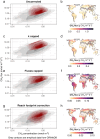Global methane emissions from rivers and streams
- PMID: 37587344
- PMCID: PMC10511311
- DOI: 10.1038/s41586-023-06344-6
Global methane emissions from rivers and streams
Erratum in
-
Author Correction: Global methane emissions from rivers and streams.Nature. 2025 Jun;642(8067):E13. doi: 10.1038/s41586-025-09130-8. Nature. 2025. PMID: 40404941 Free PMC article. No abstract available.
Abstract
Methane (CH4) is a potent greenhouse gas and its concentrations have tripled in the atmosphere since the industrial revolution. There is evidence that global warming has increased CH4 emissions from freshwater ecosystems1,2, providing positive feedback to the global climate. Yet for rivers and streams, the controls and the magnitude of CH4 emissions remain highly uncertain3,4. Here we report a spatially explicit global estimate of CH4 emissions from running waters, accounting for 27.9 (16.7-39.7) Tg CH4 per year and roughly equal in magnitude to those of other freshwater systems5,6. Riverine CH4 emissions are not strongly temperature dependent, with low average activation energy (EM = 0.14 eV) compared with that of lakes and wetlands (EM = 0.96 eV)1. By contrast, global patterns of emissions are characterized by large fluxes in high- and low-latitude settings as well as in human-dominated environments. These patterns are explained by edaphic and climate features that are linked to anoxia in and near fluvial habitats, including a high supply of organic matter and water saturation in hydrologically connected soils. Our results highlight the importance of land-water connections in regulating CH4 supply to running waters, which is vulnerable not only to direct human modifications but also to several climate change responses on land.
© 2023. The Author(s).
Conflict of interest statement
The authors declare no competing interests.
Figures













References
-
- Yvon-Durocher, G. et al. Methane fluxes show consistent temperature dependence across microbial to ecosystem scales. Nature507, 488–491 (2014). - PubMed
-
- Zhu, Y. et al. Disproportionate increase in freshwater methane emissions induced by experimental warming. Nat. Clim. Change10, 685–690 (2020).
-
- Stanley, E. H. et al. The ecology of methane in streams and rivers: patterns, controls, and global significance. Ecol. Monogr.86, 146–171 (2016).
-
- Rosentreter, J. A. et al. Half of global methane emissions come from highly variable aquatic ecosystem sources. Nat. Geosci.14, 225–230 (2021).
-
- Johnson, M. S. et al. Spatiotemporal methane emission from global reservoirs. J. Geophys. Res. Biogeosci.126, e2021JG006305 (2021).
Publication types
MeSH terms
Substances
LinkOut - more resources
Full Text Sources
Miscellaneous

